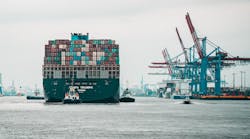Supply chain stressors have been rampant over the past few years. Global networks are starting to settle as more organizations adapt to ongoing pressures, but significant challenges remain for many businesses.
The Association of Supply Chain Management (ASCM) and KPMG’s latest supply chain stability index report found that supply chain stress remains high, despite coming down from its early 2022 peak. Organizations that hope to finally bring those levels back to normal must review the stressors they face and adapt to meet them more effectively.
Specific stressors vary across businesses, but several overall trends affect the industry. Here are five of the most common issues and how to address them.
Material Shortages
Critical material shortages are one of the biggest supply chain stressors for organizations today. Pandemic-era factory shutdowns and dramatic demand shifts have led to extreme backlogs and delays for many parts and products. Consequently, lead times for some components have grown from 14 to 40 weeks as manufacturers struggle to recover from these delays.
Semiconductors are one of the most prominent examples. Most pre-pandemic semiconductor manufacturing was concentrated in East Asia, so shutdowns in this area amid rising electronics demand caused significant disruption. More factories are under construction, but these fixes are too slow to offer immediate relief.
One of the most important steps to address this stressor is to embrace distributed sourcing and reshoring. Removing single dependencies for critical components and being geographically closer to key suppliers will minimize disruption from similar events in the future.
In the near term, organizations can increase their orders to grow safety stocks. Working closely with distributors to reduce shipping times and find opportunities to buy excess inventory from other companies is also important.
Labor Shortages
Many supply chains also face labor shortages. Nearly three in four light industrial businesses report difficulty attracting employees today, and 70% expect these challenges to persist.
Part of this shortage comes from a shift in the available workforce. Many warehouse workers are nearing retirement age, but fewer younger employees want to enter the industry. Turnover rates have reached 49% for various reasons, including rising workplace stress and tempting employment opportunities in other sectors exacerbate the trend.
The most important step in improving hiring and retention is to make workplaces more engaging and rewarding. That may include increasing pay, offering more competitive benefits, enabling flexible scheduling, providing career development opportunities and improving workplace safety.
Increased efficiency in the workplace can also offset the impact of labor shortages. Automating physical workflows with robotics and back-office tasks with artificial intelligence (AI) will reduce the workload on human employees. Warehouses can then manage higher volumes in less time despite having fewer workers.
Limited Visibility
Visibility challenges are another common supply chain stressor. Many organizations don’t maintain fully transparent relationships with their suppliers, 3PLs or other supply chain partners. That can make it difficult to see and respond to potential disruptions.
Just 21% of organizations today report having good visibility into their supplier networks. Businesses don’t know where their shipments are or what challenges their partners face until these issues already impact them. Boosting visibility will enable faster reactions, in turn improving resiliency.
Technology is the key to improving supply chain visibility. Internet of Things (IoT) tracking solutions help by offering real-time data about shipment location, quality and other factors to all relevant stakeholders. Similarly, blockchain solutions can provide immutable records of each location scan and transaction to promote transparency.
Organizations must offer this transparency into their own operations to reasonably expect it from supply chain partners. Working together to aggregate each party’s information will help stakeholders optimize their part of the supply chain.
International Tensions
Growing geopolitical tension also poses a challenge to international supply chains. Manufacturing competition and growing skepticism over fair labor policies have threatened supply chains relying on China, and the Russia-Ukraine conflict has introduced obstacles in sourcing from these nations.
The U.S. used to source 30% of its platinum group elements, 13% of its titanium and 11% of its nickel from Russia. Consequently, the supply of these critical electronics components has dramatically dropped amid the ongoing conflict. Issues like these shed new light on the delicacies of international supply chains.
Supply chains must improve their transparency amid this rising tension. Using IoT and blockchain solutions to provide more sourcing traceability will help companies understand their connections and impact. They can then see where to adjust as necessary if new restrictions or conflicts arise.
Distributed sourcing and reshoring will also help. Having sources across multiple countries—especially closer to home—will remove single dependencies more vulnerable to disruptions from geopolitical tension.
High Operating Costs
As these other supply chain stressors persist, related costs are also rising. Material prices remain high amid ongoing shortages, congestion creates higher freight rates and labor challenges may increase workforce expenses.
Some costs are declining, with global shipping rates nearing their pre-pandemic levels, but supply chains should still brace for disruption. Other factors may still increase material or labor expenses, and reducing costs will aid a faster recovery regardless of further challenges.
Digitization is an important step in reducing operating costs. Technologies like workflow automation and AI optimization can save companies up to 50% and increase revenues by 10% by increasing efficiency and minimizing human error.
Reassessing supplier and 3PL relationships may also reveal opportunities for savings. In many cases, working with digital-first partners will yield more cost-efficient supply chains than conventional workflows.
Supply Chain Stressors are Imposing, but Not Impossible
Today’s supply chain stressors pose significant challenges to businesses today, but efficient, affordable and resilient supply chains are still possible. Organizations should take these obstacles as an opportunity to adapt and become more agile in the long term. Changes now will enable optimized supply chains in the future.
These five challenges will likely persist even as some of the most dramatic disruptions fade. Supply chain disruption is inevitable to some extent, so addressing these challenges today is essential for long-term resiliency.









